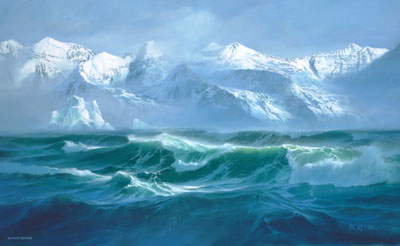The Ice Age Model
The evidence for an Ice Age that covered 30% of the high and mid latitude continents is overwhelming. Even tropical mountains were glaciated with a snow line that was about 3,000 feet lower than it is today. Glacial features are still mostly fresh, indicating the Ice Age was recent. In fact, it is considered the last major geophysical event in earth history.
Strangely, the cause of the Ice Age (or ice ages) has been and continues to be a major mystery for secular earth scientists. They have well over 60 theories: "Although theories abound, no one really knows what causes ice ages" (David Alt, 2001, "Glacial Lake Missoula and Its Humongous Floods," p. 180).
It is obvious from the well preserved beautiful horseshoe-shaped moraines at the entrance to many mountain valleys of the western United States that the Ice Age happened after the Flood. Moraines are formed at the edges (lateral moraine) and end of a glacier (end moraine) by the deposition and pushing of rocks of all sizes into ridges. These cannot be formed during global Flood runoff, but they are typical of glaciation.
The immediate climatic consequences of the Genesis Flood can produce the conditions for an Ice Age: much cooler summers (cooler than 20°F), much greater snowfall, and persistence over time. The Flood was a tremendous catastrophe that involved meteorite impacts, volcanism, and large crustal movements. Volcanism during the Flood would have created a shroud of ash and aerosols (very small particles) that became trapped in the stratosphere. The ash and aerosols reflect some of the sunlight back to space, cooling the atmosphere, especially over mid and high latitude continents. The slowly falling particles would be replenished by abundant post-Flood volcanism for which there is plentiful evidence.
The heat produced by the Flood remained in the water of the oceans. The catastrophe would have mixed the water, so the ocean was warm from pole to pole and top to bottom. Of course, there was no sea ice. The significance of a warm ocean immediately after the Flood is the great amount of evaporation it would produce, which would be the greatest at mid and high latitudes compared to today. The warm ocean water and the heat given off during condensation would end up as a large heat source for the atmosphere, keeping winters much warmer at high and mid latitude.
So, the aerosols would produce cool summers and the warm oceans, mild winters, resulting in little seasonal contrast. This took place mainly on mid and high latitude continents, adjacent to warm oceans. This combination resulted in massive snowfall that persisted year after year eventually producing ice sheets. The duration for an ice age caused by the Genesis Flood can be estimated by the cooling time of the ocean. So, the post-Flood rapid Ice Age took about 700 years. Spin offs to this Ice Age model are: 1) there was only one Ice Age; 2) the ice sheets were about 50% thinner than the crude estimates by secular scientists; 3) there was a mix of warm and cool climate plants and animals during the Ice Age; 4) millions of woolly mammoths lived in the unglaciated lowlands of Siberia, Alaska, and the Yukon Territory; 5) Antarctic and Greenland Ice Sheets mostly built up during the Ice Age with additional amounts after the Ice Age (ice cores ages are greatly exaggerated); 6) ancient ice ages claimed hundreds of millions to a few billion years ago in the evolutionary science dating scheme are really huge landslides during the Flood; and 7) the extinction of many large animals on all continents except Africa at the end of the Ice Age. For more information, see the online Books/DVDs section.
A question to ponder is: If evolutionary scientists cannot explain the last major geophysical event in earth history, while creationists can, then why should we believe them for earlier events, such as the dinosaurs died out by a meteorite impact, life evolved from non-life, innumerable evolutionary stories, etc?


